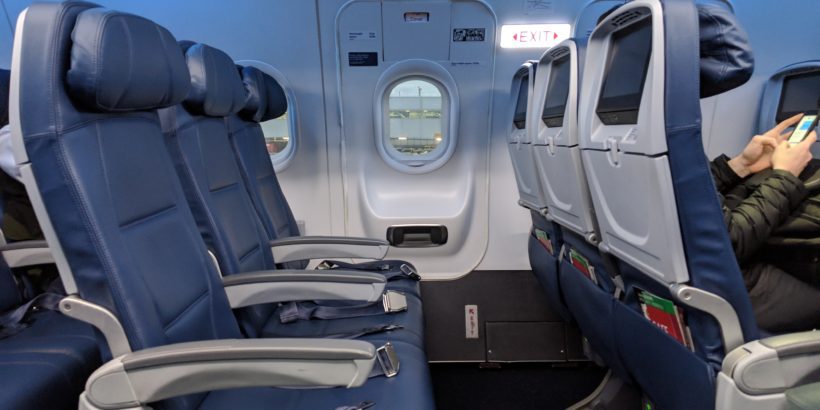If you have never sat in an emergency exit row seat you might be wondering why someone would ever choose to sit in those rows.
Doesn’t it just seem like one more thing to worry about on a flight?
Well, it turns out that there actually are quite a few perks for snagging those seats.
In this article, we will cover both the pros and cons of sitting in the emergency exit rows and give you some insight into where these rows are located on different aircraft.
We will also hit on the federal rules and restrictions regarding who is allowed to sit in the emergency exit row, so you’ll know if you are eligible or not.
Table of Contents
What is the emergency exit row?
The emergency exit row is a section of an airplane containing seats near an over-wing exit or full-sized exit door.
Sitting here is a slightly different experience from your standard economy seat. For example, the emergency exit row seats may offer more legroom but also may come with restrictions that other seats don’t have.
Keep reading below to find out more about these restrictions and everything that you need to know!
Tip: Use the free app WalletFlo to help you travel the world for free by finding the best travel credit cards and promotions!
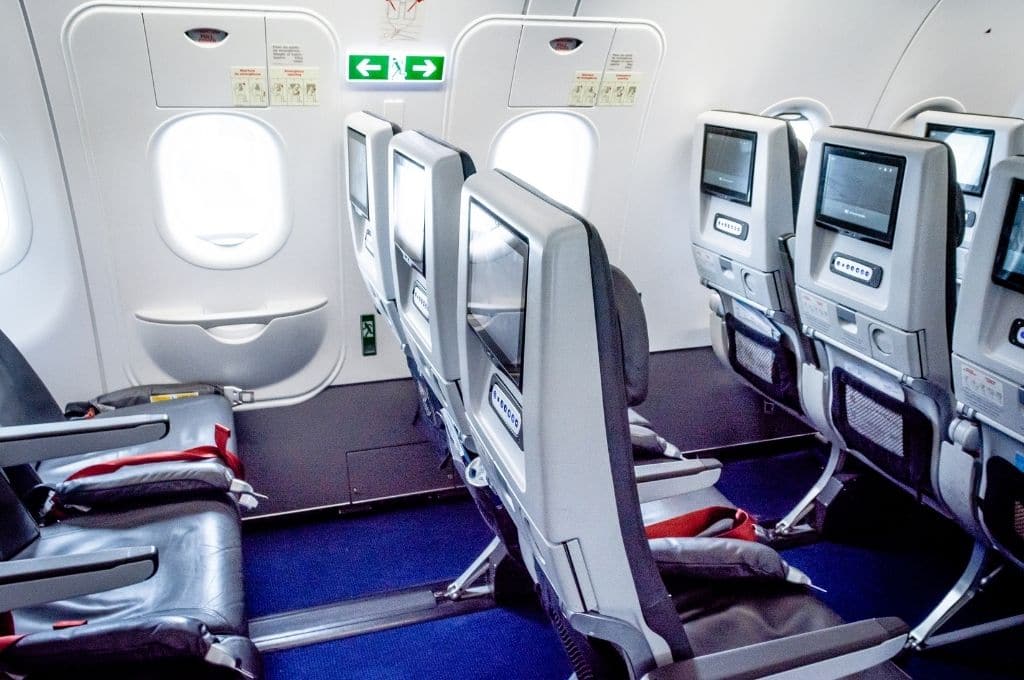
Benefits of sitting in the emergency exit row
Let’s start off with talking about the different benefits of sitting in the emergency exit row.
Extra legroom
Typically, one of the main reasons people like to sit in the emergency exit row is because they will have more legroom.
This is because you will generally find more “pitch” (the distance between seats) in the emergency exit rows.
How much extra legroom?
It depends on the aircraft but often you will have at least a couple of extra inches and in some aircraft you may have several more.
For someone who is above average in height, these extra few inches could make a huge difference especially when the flight is several hours.
Fewer seats in the row
Some rows in the emergency exit rows may only have two seats versus the three seats you would typically experience.
So if you are traveling as a couple you can have a little bit more privacy which is one reason why couples like the emergency exit rows.
And if you are seated behind one of these two seat rows, that means you have all the legroom in the world!
Cooler temps
If you are seated by an emergency exit door, you might find that the space nearby the door is a little bit colder.
That’s no surprise considering it could be about -59 F outside at 35,000 feet.
You won’t be getting frostbite but some people might need an extra sweater or blanket when sitting in this row.
Depending on your temperature preference, you might love or hate this.
Not sitting by kids/pets
The truth is a lot of passengers don’t want to sit next to kids, oversized passengers, or pets.
Because kids, some oversized passengers, and people with pets are not allowed in the emergency exit row, if you would like to optimize your comfort, the emergency exit row can be a good place for you to go.
Reduced turbulence
Not many (healthy and stable) people enjoy turbulence.
And for some people, it’s one of the worst things about traveling.
The center of the plane near the wings is known for being one of the best places to sit if you are worried about turbulence.
And often, this is where you can find the emergency exit rows.
Related: Using Turbulence Maps Ultimate Guide
Far enough from the lavatories
Sitting in the back of the plane can be one of the worst places because you may have limited recline and lots of foot traffic going in and out of the bathroom.
You also may have to deal with odors….
On the other hand, if you are seated in front of the economy section you may be prevented from using the first class lavatory and have to walk all the way to the back of the plane to use the bathroom.
But if you are seated in the emergency exit row in the middle of the plane, you are not so far from the bathroom but also not too close.
Did you know? It is basically impossible for the emergency exit doors to open during flight due to cabin pressure.
Downside of sitting in the emergency exit row
More expensive
Some airlines will require passengers to pay more money when choosing a seat in the emergency exit rows.
Sometimes they will consider the emergency exit row seats to be part of the “economy plus” section which is usually slightly more expensive.
For example, when I was looking to book a flight between Tucson and San Francisco, United allowed me to select my seats in the emergency exit row but notified me that I would have to pay $45 to $59 for the seat selection.
Often if you select seats like this you can get extra perks like priority boarding and sometimes even free alcohol.
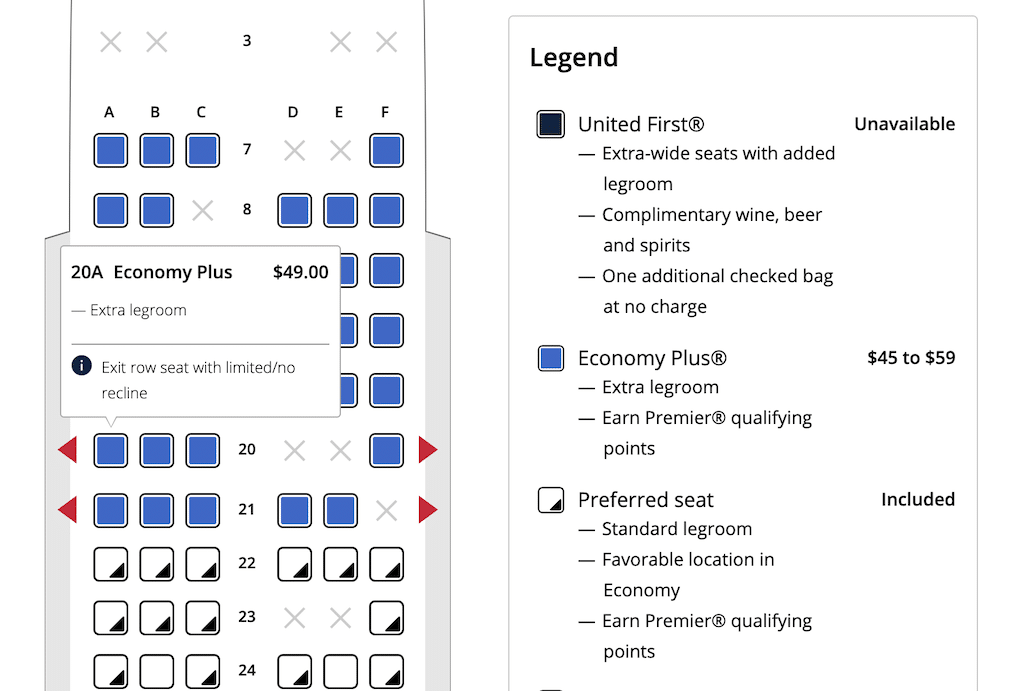
More difficult to book
Some airlines make booking the emergency exit rows more difficult.
They might reserve them for elite members or not allow you to book them until the last minute.
In other cases they might be classified in such a way that you even have to call in to select your seat. So in some situations you may have to jump through a couple of hoops to get your seat.
Lack of recline
Some of the seats in exit rows will not allow you to recline.
This is typically the case if there are multiple rows of exit row seats for one exit and the seats don’t recline because it would clutter up the space for a clean exit.
Reclining on shorter domestic flights is overrated anyway so I don’t consider this a major con.
Related: 9 Tips to Politely Recline Your Airplane Seat
Different tray tables
Seats in the emergency exit row may have different types of armrests and tray tables than other economy seats.
A standard economy seat may have a tray that drops down from the seatback in front of it but some seats in the emergency exit row may have a tray table that pops out of the armrest.
This means that you will not be able to put the armrest up or down which could be more restrictive for some passengers.
Engine noise
If your exit row is located on or near a wing you may be subjected to louder engine noise. (The front of the plane is always going to be the quietest because you are in front of the engines.)
Some emergency exit rows are in front of the engines so this is not always a drawback.
Obstructed views
Once again if your exit row is on a wing your view out of the window may be largely obstructed from the wing.
If there is an empty seat next to the window, you also might have to stretch out to even catch a window view.
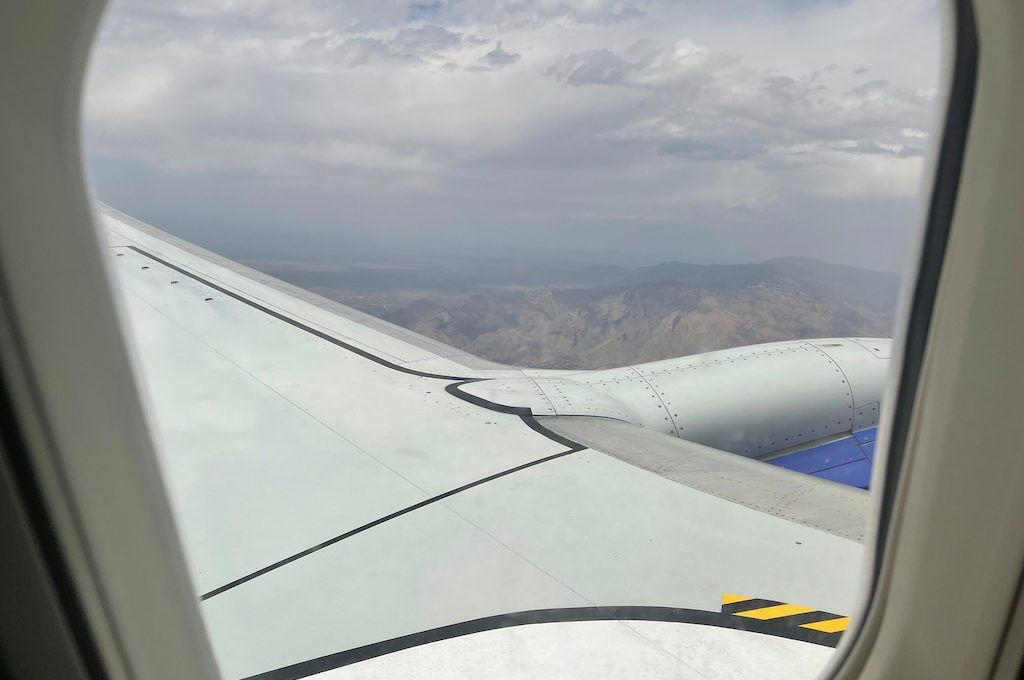
Under seat luggage
Depending on the aircraft and airline, you may have issues trying to store your belongings underneath the seat in front of you when sitting in the emergency exit row. Some airlines seem to allow it while others may prevent you from putting anything under the seat.
This means you will have to store all of your carry-on and personal items in the overhead storage bin similar to if you were sitting in the bulkhead.
Outside of takeoff and landing, you may be able to store your belongings under the seat as long as they do not protrude.
Longer wait to get off the plane
Since you will be seated in the middle of the plane you will not be one of the first people to exit the aircraft.
In fact, you could be among the last to get off the plane.
We once arrived in a Caribbean destination when seated in the emergency exit row and the plane deplaned from both the front and the back.
This forced us to be among the very last passengers off the plane which was not very fun because there was a soul-crushing long line for immigration when we finally exited the aircraft.
Extra instructions
This is not the biggest deal to a lot of people but if you are in an emergency exit row you might have to listen to extra instructions about what to do in the event of an emergency.
One thing that I have seen happen (on several occasions) is someone jamming out with their headphones on and getting called out by the flight attendant who is trying to brief the passengers on what they might have to do.
Extra (legal) responsibility
While you might have more room to spread out your legs, by sitting in the emergency exit row you are forced to assume extra duties that could be vitally important.
In a worst-case scenario, your actions could mean the difference between someone living or dying and so your decision to sit in the emergency exit row should not be taken lightly.
There also might be legal implications to your decision to sit in those seats — you could be sued for negligence, for example. So once again you should think through your choice thoroughly.
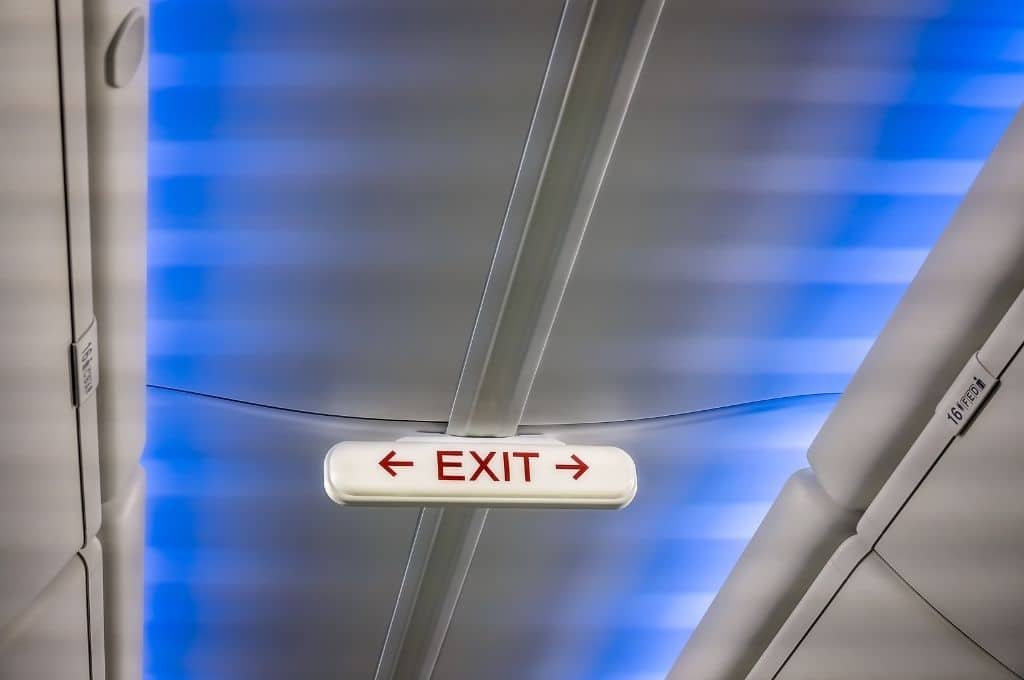
Where is the emergency exit row?
There are two types of emergency exits: over-wing exits and full-sized exit doors.
The over-wing exit rows are going to be located in the middle of the plane (where the wing is attached) and will usually be a smaller window exit. Meanwhile, the full-sized exit door rows will typically be found towards the front or back of the plane (but sometimes can be near the middle).
Because of the different aircraft and multiple exits, there is no way to predict if you will be in an emergency exit row based solely on your row number.
Instead, you will have to check the seat map for your specific aircraft. You can do this with a website called SeatGuru but you can also often view the emergency exit rows whenever you are selecting your seat with the airline.
Below are four different examples with the different aircraft. You’ll see a 787 Dreamliner from United, A321 from JetBlue, 737 from Southwest, and an A350 from Delta. Notice how on the Southwest 737 the exit rows are over the wing but they are not like that with the other aircraft.
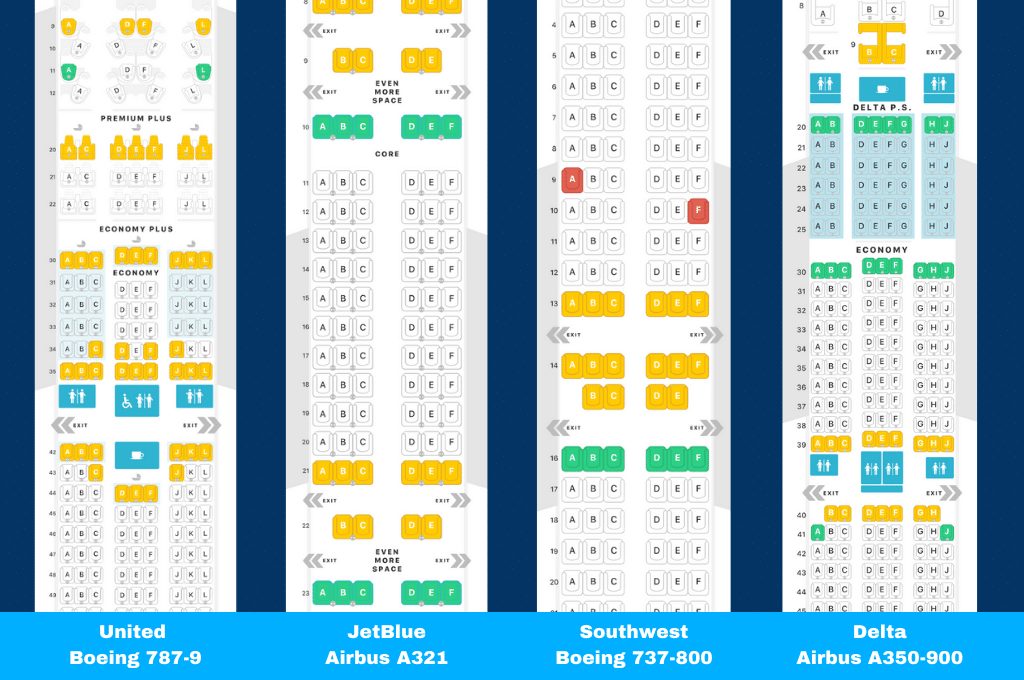
Rules for the emergency exit row
Not everyone can sit in the emergency exit row.
A good rule of thumb is that if you are preboarding you will not be allowed to sit in the exit rows (there are some exceptions).
But there are also specific instances outlined by the FAA that spell out exactly who is not allowed.
Based on 14 CFR § 121.585(b), there are situations where individuals may not be allowed to sit in the emergency exit row.
The reason is that they may not have the ability to successfully complete the duties talked about below.
The situations where you may not be allowed in the exit row include the following.
Mobility issues
If “[t]he person lacks sufficient mobility, strength, or dexterity in both arms and hands, and both legs” they may not be allowed because they may have issues performing the emergency exit duties.
The lack of mobility provision could apply to people who are severely overweight and struggle to move around quickly or in tight spaces.
Note: If you need a seatbelt extender some flight attendants may ask you to choose a different seat from the exit row.
Under the age of 15
If the individual is “less than 15 years of age or lacks the capacity to perform one or more of the applicable functions [ . . . ] without the assistance of an adult companion, parent, or other relative” they may not be seated in the emergency exit row.
This is a major reason why unaccompanied minors are not allowed in these seats.
Reading comprehension
If “[t]he person lacks the ability to read and understand instructions… in printed or graphic form or the ability to understand oral crew commands” they may be unable to be seated.
A lot of airlines will want to make sure that passengers in the emergency exit row can read and understand the native language of the home country of the airline.
I am assuming that if someone is illiterate this could also disqualify them.
Visual issues
There is also a restriction for sight.
If a passenger “lacks sufficient visual capacity to perform one or more of the applicable functions… without the assistance of visual aids beyond contact lenses or eyeglasses” they aren’t allowed in the emergency exit row.
In other words, if you have a visual impairment, you’re not allowed to sit in the emergency exit row.
Hearing issues
Also, if you have hearing issues, that can be significant enough to keep you out of the exit row as the statute states the passenger cannot lack “sufficient aural capacity to hear and understand instructions shouted by flight attendants, without assistance beyond a hearing aid.”
Communication skills
And finally you won’t be able to stay in the emergency exit row if you lack “the ability adequately to impart information orally to other passengers.”
I take this to mean that if you have severe cognitive deficiencies, you may not be able to be seated in the exit row.
Note that some airlines have their own requirements that they publish. They usually follow along with federal law but may have additional requirements. You can check out the Southwest rules here.
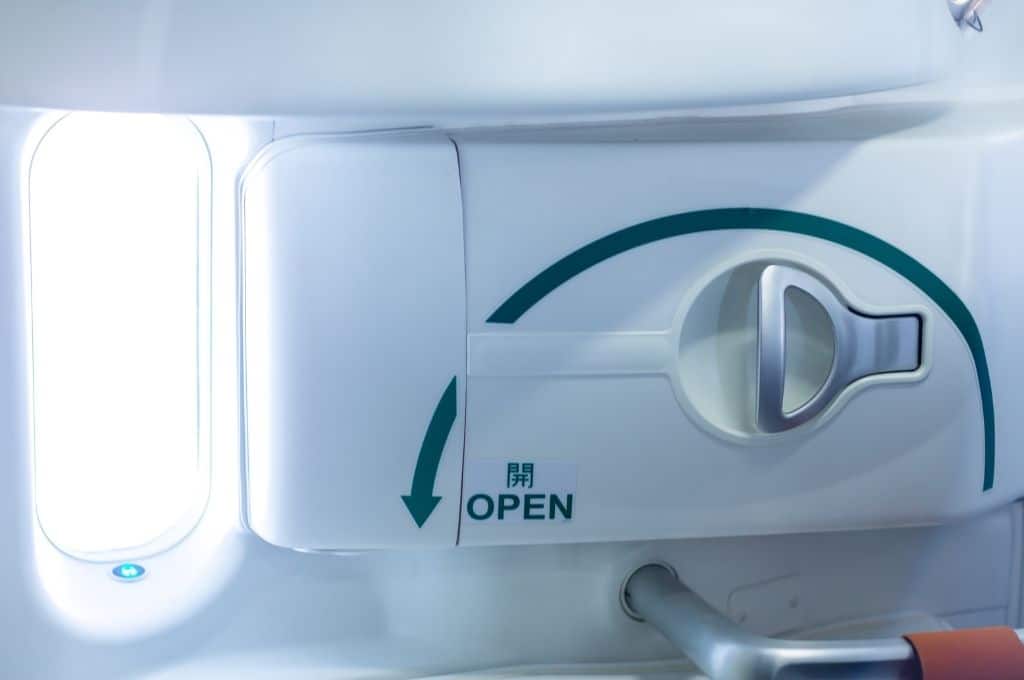
What are the emergency exit row duties?
So assuming that you are qualified to sit in the emergency exit row, what could you be expected to do in the event of something going wrong?
Well, you’re not exactly expected to be Captain America but the statute lists 10 different duties you could expect.
These include being called upon to:
- Locate the emergency exit;
- Recognize the emergency exit opening mechanism;
- Comprehend the instructions for operating the emergency exit;
- Operate the emergency exit;
- Assess whether opening the emergency exit will increase the hazards to which passengers may be exposed;
- Follow oral directions and hand signals given by a crewmember;
- Stow or secure the emergency exit door so that it will not impede use of the exit;
- Assess the condition of an escape slide, activate the slide, and stabilize the slide after deployment to assist others in getting off the slide;
- Pass expeditiously through the emergency exit; and
- Assess, select, and follow a safe path away from the emergency exit.
It’s really important to consider what these duties would entail in practice.
It’s not just about pulling a lever to open the door but there are actual needs for judgment calls to be made.
Are you someone who does okay that type of pressure or would you fold like a lawn chair?
Some passengers might feel safer sitting by the emergency exit because they could presumably be the first people out of the plane in the event of something like a fire.
But if you were to exit that quickly you might be forced to neglect some of the duties you would be called upon to do like stowing the emergency exit door.
Again, you could be sued for negligence.
If you are wondering what it would be like when an emergency exit door is being opened, check out the videos below and they will give you a pretty good picture of what it will look like.
Here’s a video of a window exit being opened:
Here’s a video of an emergency slide being deployed:
Final word
Personally, I am a major fan of the emergency exit rows. I have flown in them many times especially when flying Southwest. For certain people that value legroom and extra privacy it can be well worth it to pay a little bit extra for them but in the back of your head you should always think about what you might be called upon to do in the event of an emergency.
Daniel Gillaspia is the Founder of UponArriving.com and the credit card app, WalletFlo. He is a former attorney turned travel expert covering destinations along with TSA, airline, and hotel policies. Since 2014, his content has been featured in publications such as National Geographic, Smithsonian Magazine, and CNBC. Read my bio.

